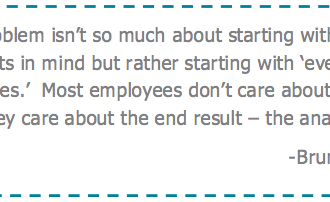A few weeks ago my colleague Jens Boivie (sales executive training in the Nordics) sent me a link to this Fast Company article, “How GM Is Saving Cash Using Legos as a Data Visualization Tool.” It stuck with me ever since so I had to share it with you.
A few weeks ago my colleague Jens Boivie (sales executive training in the Nordics) sent me a link to this Fast Company article, “How GM Is Saving Cash Using Legos as a Data Visualization Tool.” It stuck with me ever since so I had to share it with you.
My takeaways:
- People choose tools that are easy and fun. It’s pretty basic. We like to feel happy! According to this Fast Company article, Tim Herrick, global chief engineer at GM, uses Lego pieces with his organization to track problem resolution; various colors denote the area of the vehicle and the block size denotes the severity of the problem. Likewise, Dennis Pastor, executive director of performance excellence at WellStar Health Systems, uses Lego bricks with his organization — they track on-time starts at the doctor’s office and manage physician-payee relationships, which has led to a series of fixes projected to save the company $1 million USD. What could be easier and more fun that using that mainstay of childhood — Lego — at work!
- Humans think in 3D. This is something that was on my mind every day when I was an independent industry analyst covering workplace use of immersive technologies (you can find my old ThinkBalm analyst reports and videos here). By 3D I don’t mean “made to look as if slightly popped up from the page.” I mean utilizing three dimensions of space: an X, Y, and Z axis — either physically, as in the case of GM and WellStar using Lego, or virtually, as in immersive serious games and virtual worlds. Pastor said, “We came to the conclusion that our processes were three dimensional but our reports were only two dimensional. We needed to see them 3D . . .”
- 3D is natural for Business Discovery. There are many ways Business Discovery can become more three-dimensional to take fuller advantage of the capabilities of the human mind. For example, imagine integrating QlikView with motion sensing input devices like Microsoft Kinect, enabling users to interact with apps by moving their bodies around in physical space . . . literally feeling the data. (See the blog post and video, “QlikView’s Simplicity Opens the Door to Innovation.”) Imagine QlikView apps displayed on multiple screens on the walls of factory or warroom, literally surrounding decision makers with data, providing an ever-present status indicator and opportunity for instantaneous exploration.
You think I’m out to lunch with this 3D stuff? Bah, this is nothing! Check out the blog post, “Data Visualization in 4D: Sculpture and a Musical Score.” ![]()







